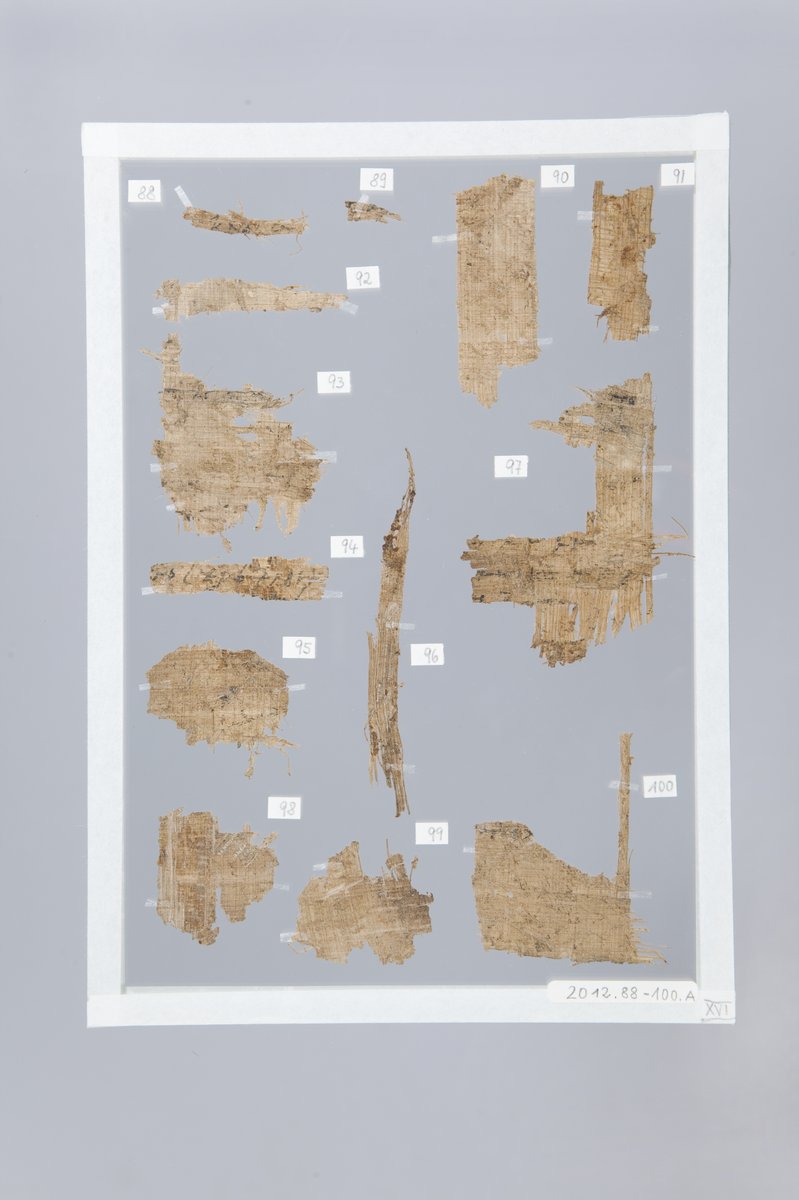
Fragment of a papyrus from Egypt with Greek inscription
Classical Antiquities
| Date | ca. 330–320 B.C. |
|---|---|
| Object type | relief |
| Medium, technique | carved, Pentelic marble |
| Dimensions | 172 × 104 × 37 cm |
| Inventory number | 6259 |
| Collection | Classical Antiquities |
| On view | Museum of Fine Arts, Basement Floor, Classical Antiquity, Hellas – Italy – Rome |
The nearly life-size monument is carved from Pentelic marble, has a reddish patina and represents three figures in high relief. On the left, a nude, athletic man stands in a relaxed posture; his folded mantle, thrown over his left shoulder, hangs down from his lower arm. A woman stands on his right, turning towards him; she wears a long chiton sweeping the floor and twisted at her waist, her himation covering the left shoulder. From what remains of her neck, she seems to be looking at the man, and resting her left hand on his shoulder (only fragments of her fingers remain). The right hands of the two figures were probably clasped in a gesture indicating affectionate relationship in classical Greek art. Between them is a boy represented on a much smaller scale, but with the proportions of an adult, and a stance conveying a meditative expression. The relief, carved from a single block of stone, must have stood in a marble niche, and perhaps crowned an Athenian tomb. Although the relief bears no inscription, there are two elements of the composition indicating that of the three figures, it is the man represented as the deceased. It is first of all his nudity that suggests that he has passed beyond the realm of the living. In contemporary Athenian art, it was primarily gods and heroes who were portrayed this way; mere mortals depicted in this schema were usually children or athletes, the latter always accompanied by some item of sporting paraphernalia. No such items appear in the Budapest gravestone. Furthermore, and unusually for the funerary art of the period, the young, athletic body of the man is crowned with a middle-aged face. Even though the woman turns towards him, the introspective gaze of the man seeks no contact with the woman. He looks past her; he is no longer in this world. The boy between them is not their son, but a servant, as suggested by his hairstyle differing from the standard representation of Athenian children, and also by his nudity, in this case indicative of servitude. The protagonist of the relief is thus an unknown Athenian; yet the representation shows no individuality. It is precisely this lack of individuality that makes it such a characteristic example of 4th century B.C. Athenian funerary art. The stele expresses the ideal man of classical Athens, the idea of a man “beautiful and good” (kalos kai agathos). The series of classical tombstones began in the last decades of the 5th century BC, following the completion of the Parthenon, and ended with the sumptuary laws of 317 B.C., which banned the luxury of tombs. The Budapest gravestone must have been made in an Athenian workshop not long before. After this piece, the unknown artist is referred to as “the Budapest Sculptor”. In the decades following the collapse of the Austro-Hungarian Empire, opportunities for enriching the Collection of Classical Antiquities became few and far between. Among the rare exceptions is this Athenian gravestone, a wonderful example of late classical Greek art, acquired in 1928 through the joint efforts of Elek Petrovics, the legendary director of the Museum of Fine Arts, and archaeologists Antal Hekler and Paul Arndt. Following ÁRPÁD MIKLÓS NAGY
Marble analyses have shown that the funerary relief was made of Pentelic marble.
This record is subject to revision due to ongoing research.